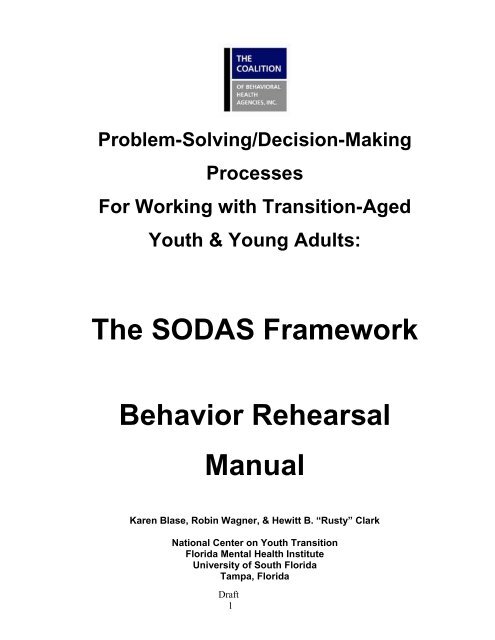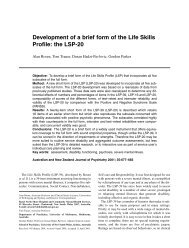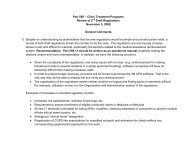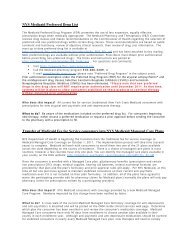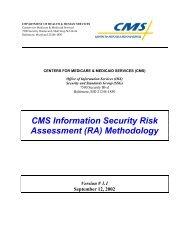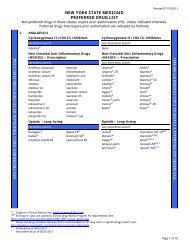The SODAS Framework Behavior Rehearsal Manual
The SODAS Framework Behavior Rehearsal Manual
The SODAS Framework Behavior Rehearsal Manual
You also want an ePaper? Increase the reach of your titles
YUMPU automatically turns print PDFs into web optimized ePapers that Google loves.
Problem-Solving/Decision-Making: <strong>The</strong> <strong>SODAS</strong> <strong>Framework</strong>Youth InstructionsPractice Session 1SituationYou are meeting with your Transition Facilitator for your weekly meeting. You arediscussing how things in your life are going and you share with him/her that two of yourfriends got arrested last week because they got caught shoplifting. You express relief thatyou were not with them. You tell the Transition Facilitator that you hope you don‟t getcaught in the future when you are with your friends and they are shoplifting.Instructions• Be cooperative with the Transition Facilitator and open to him/her teaching yousomething new, unless otherwise stated in these instructions.• Remember your input from the Strength Discovery ProcessYour friends are important to youYou like having nice thingsYou want to start workingYou like working with childrenYou want to be an elementary teacher one dayYou have a close relationship with your grandmother.• If the Transition Facilitator does not explain how problem solving and decisionmakingcan benefit you, you should behave as if you are not interested in whathe/she is teaching you and you can say, “Well, I don‟t see how this is going to helpme”.• Do follow any suggestions or directions the Transition Facilitator gives you but youmay ask one question or make a comment to clarify each of the steps, e.g., “What‟san option?”• Be conversational with the Transition Facilitator, remembering your strengths fromthe Strength Discovery process and help brainstorm options, disadvantages,advantages, and solutions.• Be willing to compromise to arrive at a solution that meets some of your needs aswell as being something that would realistically work for you.Draft5
Problem-Solving/Decision-Making: <strong>The</strong> <strong>SODAS</strong> <strong>Framework</strong>Youth InstructionsPractice Session 2SituationYou are meeting with your Transition Facilitator for your weekly meeting. In this meeting,as the Transition Facilitator is asking you how things have been going, you tell him/her youthat you want to quit your current job. You tell him/her that you no longer feel like workingthere.Instructions• Be cooperative with the Transition Facilitator and open to him/her teaching yousomething new, unless otherwise stated in these instructions.• Remember your input from the Strength Discovery ProcessFriends are important to youYou like to have money to spend with friendsYou are persistentEventually you want to live on your ownYou want to own your own small business somedayYou have a close relationship with your uncle who used to own a business• As you explore the situation, let the TF know that you want to quit because the workis too hard. <strong>The</strong>n let it emerge that you can‟t really read well enough to read the onthe job training material and you are embarrassed to ask for help.• If the Transition Facilitator does not explain how problem solving and decisionmakingcan benefit you, you should behave as if you are not interested in whathe/she is teaching you and you can say, “Well, I don‟t see how this is going to helpme”.• Do follow any suggestions or directions the Transition Facilitator gives you but youmay ask one question or make a comment to clarify each of the steps, e.g., “What‟san option?”• Be conversational with the Transition Facilitator, remembering your strengths fromthe Strength Discovery process and help brainstorm options, disadvantages,advantages, and solutions.Draft11
• Be willing to compromise to arrive at a solution that meets some of your needs aswell as being something that would realistically work for you.Draft12
Problem-Solving/Decision-Making: <strong>The</strong> <strong>SODAS</strong> <strong>Framework</strong>:Transition Facilitator InstructionsPractice Session 2SituationYou are meeting with one of your young people today. In this meeting as you are askingthe young person how things have been going, the youth tells you that he/she thinks he/shewants to quit his/her current job. <strong>The</strong> youth says that he/she no longer feels like workingthere.Instructions• Remember the following from the Strength Discovery process:friends are important to him/herlikes to have money to spend with friendsis persistenteventually wants to live on his/her ownwants to own his/her own small business somedayhas a close relationship with his/her uncle who used to own a business• You are concerned about this young person‟s future and him/her staying employed.You see this situation as an opportunity to use the <strong>SODAS</strong> framework, hopefully, tocome to a solution that will have better outcomes for this young person.• You also want to help the youth to start to think of other ways of dealing withsituations instead of just reacting to his/her initial feelings so that the youth canrealize that his/her behavior has consequences and that he/she can change his/herbehavior to help lead to better outcomes for him/herself.• Use the <strong>SODAS</strong> format and worksheet for decision-making and problem-solving tohelp this young person.• Summarize at the end of each component, e.g. “so it sounds like the situation is…”•or “okay, the options that are listed so far are…”.Draft13
Problem-Solving/Decision-Making: <strong>The</strong> <strong>SODAS</strong> <strong>Framework</strong><strong>Behavior</strong> <strong>Rehearsal</strong> Leader InstructionsPractice Session 2Situation<strong>The</strong> youth and Transition Facilitator are meeting today. In this meeting as the TransitionFacilitator is asking him/her how things have been going, he/she tells the TransitionFacilitator that he/she thinks he/she wants to quit his/her current job. He/she says thathe/she no longer feels like working there.Instructions• Before the training session, read the Instructions for the Transition Facilitator andthe Youth to get a picture of how the scene fits together.• Provide the General Instructions to all the participants.• Ask for volunteers or assign participants to play the roles of the TransitionFacilitator and the Youth.• Provide the Transition Facilitator with the “Transition Facilitator Instructions” andthe <strong>SODAS</strong> Component Checklist to use as a reference as well as the <strong>SODAS</strong>Worksheet to record the information that the TF and Youth come up with duringthe practice session.• Provide the Youth with the “Youth Instructions”.• Provide any Observers with the <strong>SODAS</strong> Component Checklist and ask them tofollow along with the process.• Ask the Transition Facilitator to let you know during the session if he or shewants ideas or help.• Ask the Transition Facilitator to begin by asking the youth how things have beengoing (the youth will then share the news about his/her friends and lead intohis/her statement about hoping he/she does not get caught in the future).• You will record the Transition Facilitator‟s behavior on the <strong>SODAS</strong> <strong>Behavior</strong><strong>Rehearsal</strong> Feedback Sheet. You may elect to periodically stop the scene, givefeedback and then tee the scene up to continue or you may elect to let theparticipant complete the scene before giving feedback.• When giving feedback be sure to:Draft14
a. Take a strength-based approach and describe all the ways that the TransitionFacilitator used the <strong>SODAS</strong> components appropriately as well as theappropriate use of quality components (e.g. voice tone, praise).b. When offering corrective feedback, describe the behavior to be changed andoffer words that the Transition Facilitator might use instead of the approachtaken by the Transition Facilitator. However, the TF need not use your exactwords in any re-practice that occurs.c. Feel comfortable asking the Transition Facilitator to re-practice and offerpraise and support for the Transition Facilitator‟s receptivity to feedback.Draft15
Appendix<strong>SODAS</strong> FormsThis appendix contains a Practice Demonstration and several forms that will be used duringthe <strong>SODAS</strong> behavior rehearsals. <strong>The</strong>se forms will also prove useful as you continue topractice these methods and begin applying them with young people, their families, andother key players.<strong>The</strong> Practice Demonstration is “Introducing <strong>SODAS</strong> in Context”This is borrowed from the <strong>SODAS</strong> Personnel Training Module.Diagram of the <strong>SODAS</strong> MethodIn addition to a PPT HANDOUT on <strong>SODAS</strong>, this <strong>Behavior</strong> <strong>Rehearsal</strong> <strong>Manual</strong> containsseveral forms that should prove to be useful during training and booster sessions,as well as in your implementation of <strong>SODAS</strong> in your work with young people.<strong>SODAS</strong> Component Checklist - to be given to all participants to guide them asthey follow along throughout the behavior rehearsal to ensure components are beingincluded.<strong>SODAS</strong> Worksheet – to be given to the Transition Facilitator and the Youth to usein guiding their interaction, particularly in setting the Situation and Options initially.(Transition Facilitator or youth can record the information on it). <strong>The</strong> youth may notwant to record the information, and that is okay, but the Transition Facilitator shouldbe careful to put the sheet in the middle of him/herself and the youth so that theyouth feels a sense of ownership of the process and does not feel the TF is „incharge‟.<strong>SODAS</strong> <strong>Behavior</strong> <strong>Rehearsal</strong> Feedback Sheet – to be given to the <strong>Behavior</strong><strong>Rehearsal</strong> leader to use as a guide and recording sheet to track feedback on theTransition Facilitator‟s behavior during the behavior rehearsal.Draft16
Practice Demonstration: Introducing <strong>SODAS</strong> in ContextParticipants’ Practice DemoTF = Transition FacilitatorY = YouthNarrator reads italic to support the demo = Read statements in italicsScribe = summarizes on the <strong>SODAS</strong> Worksheet for use by TFs.SAMPLE <strong>SODAS</strong> DEMOTF: Well, sometimes when you are making a big decision it helps to take a step backand think about it. Other kids tell us that learning problem solving has helped them makegood decisions about their futures. Is it okay if we spend a few minutes talking about workand problem solving? Great!S = SituationTF:One of the first steps is really understanding what‟s happening for you right now.And if you are bouncing ideas off of someone else, being really clear helps the otherperson be more supportive and understanding. So let‟s see if we can get a clearpicture of the situation. That means you can tell me about why you are making thedecision to quit and I will just ask you some questions so I can understand what youare thinking about and why you are going to quit your job. Okay?Y: I guess.TF:So you are really thinking about quitting your job? What‟s up with that? Last weekyou were pretty happy with that paycheck.Y: Yeah, but I can get another job.TF: Is something bothering you about your job? Starting a new job can be a realchallenge sometimes. Lots to learn, new people. [Do: offer empathy and promptsand be curious. Don‟t: Lecture or argue about how hard it is to get a new job]Y: Yeah, well some people think they can just push you around and I don‟t have to takethat crap.TF: Sounds tough. Who‟s pushing you around? Your boss?Y: Naw, it‟s this other guy, Frank, who keeps raggin‟ on me.TF: What‟s his problem?Y: He‟s always telling me what to do when I know what I‟m supposed to be doing.Anyway he is not the boss.TF: So, like what kinds of things does he say? [Do: Gently ask questions to get all theinformation, much like a “reporter” discovering who, what, when, where and howoften. Try to get at the specifics by using words like “what did he say” “what did youdo”. Words such as “do” and “say” are more likely to elicit behavioral descriptions.Such behavioral descriptions help you see what is happening for the youth. You andthe youth need a very clear picture of what‟s happening in order to generate optionsand evaluate them]Y: [<strong>The</strong> youth goes on to describe being called stupid and told to hurry up]Draft17
TF: So, Frank is on your case a lot about moving faster and is calling you “stupid” butyour boss says you are doing okay. And this is happening a bunch of times everytime you have to work with Frank?Y: Yeah, and I don‟t have to take it so I am leaving that job.O = OptionsTF: Okay, so I think I‟ve got a clear picture of your situation. <strong>The</strong> next step in problemsolving is getting a bunch of different ideas on the table about what you can doabout the situation. People call these options because what you are doing isthinking about the different choices you could make before you do something.Sometimes our first ideas are great, but sometimes we can come up with betterones when we take time to think. Let‟s see what we can do together to come upwith more ideas. I‟ll keep track of them on paper for us [or let the youth do this].TF: So one choice you could make is that you definitely can quit. So “quit my job” is thefirst idea. [It‟s a challenge for many adults to just accept an option that the adultdoes not feel is a good one. But remember that at the end of the day the youthWILL make his or her own decision. By letting options stand for examination youshow you respect the youth‟s opinion, you keep the dialogue going and you createthe opportunity for the youth to learn to solve problems more systematically andcarefully. But it does not mean that the youth will choose the same path you wouldchoose!]TF: What else could you do?Y: I could meet him in the parking lot and tell him to back off or he‟s gonna hear fromme!TF: Okay, so another option is to confront him in the parking lot and it sounds like youthink threatening him would be an option?Y: Yeah, but I wouldn‟t really do nothin‟.TF: Well, let‟s write that one down too, “meet him in the parking lot and tell him to backoff or he‟s gonna hear from you”. [Again, avoid lecturing. Notice that the TransitionFacilitator labeled the behavior as confrontational and threatening, but went back toa behavioral description in the youth‟s words of the option. Sometimes you can helpthe youth build on an option that at first seems problematic.]TF: Any other ideas?Y: Nope. [Some youth can be frustrated by the process or feel „put on the spot‟ tocome up with other options. Offering ideas and empathy is appropriate.]TF: I know it can be frustrating to think through this stuff and that right now you just wantto quit. But hang in with me for minute and let‟s see what we can come up with.Okay?Y: I guess.TF:So you can quit or you can meet him in the parking lot and talk to him. Do you thinktalking to your boss about it is an option?Y: No way am I gonna rat him out. That would so not be cool.TF: A. Okay, let‟s take that off the table for now then.orB. Well, it doesn‟t sound like you are too excited about that idea, but how aboutif we leave it on the list for now?[Use your own judgment, given the youth‟s reaction, about whether or notto pursue an option in the next phase.]Draft18
TF:What else could you do? [<strong>The</strong> conversation continues until the youth and TransitionFacilitator feel they have a few good ideas to explore. More options can arise as thedisadvantages and advantages are pursued. It is best to generate a few optionsbefore beginning to examine advantages and disadvantages of each so that theyouth can contrast and compare the advantages and disadvantages].D = Disadvantages and A = AdvantagesTF: You‟ve done a great job of coming up with options! [Remember to praise the youthfor engaging in the process!] Well at this point, you‟ve got three options or choicesfor yourself:1) Quit your job.2) Talk to Frank in the parking lot and tell him to back off.3) Ignore Frank and just go on with your work.<strong>The</strong> next step is to take a look at each of these and see what the positives andnegatives or the upside and downside is for each of them. By looking at thedisadvantages and advantages you can choose the consequences you want todeal with and pick a solution that makes the most sense to you. Every idea has itsgood points and bad points.TF: Okay, so let‟s look at this “quitting the job” idea you mentioned first.What are the advantages of that idea? Or, What good things might happen if youchoose that idea? Or, What are the benefits of quitting? [Use language that fits forthe youth].Y: Well, I won‟t have to take that crap anymore.TF: So are you saying you would feel relieved and less frustrated because you wouldn‟thave to put up with Frank‟s comments on the job? [Do: Explore the emotional sideof the choices. This can be a great opportunity to broaden a youth‟s emotionalvocabulary as well as giving the youth an opportunity to confirm what you are sayingor correct you.]Y: Yeah, and I wouldn‟t be so pissed off!TF: Any other positives to quitting?Y: Well, I would have more time to spend with my friends instead of working.TF: And that could be a lot of fun couldn‟t it? So, you would be free from Frank‟sbugging you and you could spend more time with your friends if you quit your job.[Summarize as you go.] Anything else good about it?Y: That‟s all I can think of now.TF: What about the downside of quitting….anything you might not like about quitting?Y: Well, I wouldn‟t have any money to spend.TF: What do you like to spend your money on?Y: Food, movies and my girlfriend.TF: So, while you might have more time to spend with your friends you might not haveas much money to spend. So less food, fewer movies and less money to spend onyour girlfriend are part of the picture if you quit your job.Y: But I can get another job, a better one.TF: Okay, let‟s put that back up with the advantages of quitting, you might get a betterjob. Any disadvantages of having to look for work?Y: I might not find work right away.Draft19
TF:That‟s true. So it might take a while to get back to having spending money. Are youthinking of quitting right away?Y: Yeah, tomorrow.TF:Hmm. I wonder if your boss will give you a good recommendation if you quit all of asudden. What do you think he says about employees who up and quit without anynotice? Why is that hard on him? [Part of teaching youth to think aboutconsequences involves helping them learn to consider the point of view of otherpeople and the likely outcomes that result from the impact of their behavior onothers].Y: Maybe not but what if I told him I was quitting in a week?TFThat would help him out because then instead of thinking, “Man this kid is troubleand not very responsible, I hope he doesn‟t screw the next boss.” He might think,“Well, at least he didn‟t just quit and not show up for work and leave mehanging…that was pretty responsible of him. I think I can give him a goodrecommendation.” [Some Transition Facilitators find it effective to „role play‟ whatothers might say or think to make the youth‟s impact on others more real to theyouth.]TF: So maybe you‟ve changed that first idea a little by saying you are going to quit butyou will give your boss at least a week‟s notice? Good thinking. [Options frequentlyget modified and improved as the advantages and disadvantages are explored].Y: Yeah, that sounds good. Maybe I won‟t even quit until I get me a new job!TF:Wow! <strong>The</strong>re‟s an idea. Why does that sound good to you?<strong>The</strong> Transition Facilitator and the Youth continue to review each option, theadvantages and disadvantages and make revisions as they go. At the end of thissection the youth or the Transition Facilitator can summarize each option and theadvantages and disadvantages in order for the youth to choose a solution.Sometimes the youth clearly gets very committed to an option along the way. <strong>The</strong>reis no rigid rule that says you must go through every option if in fact the youth hassettled on a safe option along the way.S = SolutionTF: You have done a terrific job of thinking things through. You had more than oneoption to think about and you came up with pretty real advantages anddisadvantages for each one! Now it‟s time for you to choose your option and theadvantages and disadvantages that go with it. [Youths don‟t always realize thatwhile they can choose any option, they may not be in control of the consequences oftheir choice. So reminding them that they are choosing an option and the attendantdisadvantages and advantages can be helpful and educational.]Y: I think I better get me a new job first and then quit!TF: Okay, so let‟s review the advantages and disadvantages of that choice:<strong>The</strong> good news is that you would continue to have spending money and, if you givenotice, you stand a better chance of getting a good recommendation from youremployer. <strong>The</strong> bad news is that you are going to have even less free time becauseyou are going to be working AND looking for a new job. Anything else to thinkabout?Draft20
Y: Can you help me find a new job?TF: Sure, you can use all the skills you learned in getting the job you have now and I canhelp with leads, reviewing your applications and transportation to interviews. Howdoes that sound?Y: Good.TF: When it comes time to give notice do you want to practice what to say to your bossso he will be more likely to feel okay about it and how to ask for a reference for thefuture?Y: I can handle it by myself.TF: I‟m sure you can, but if you change your mind about a run through let me know andwe can talk it over. Let‟s set a specific time to get back together and go over somejob-hunting steps for your next job. Do you still get a newspaper at home?…..Follow-up<strong>The</strong> Transition Facilitator makes a phone call to the youth at home the day afterthe youth was to implement the plan. It may have gone well, and if so,might sound like this:TF: So, how did it go when you told your boss you would have to quit?Y: Pretty good. He said he was glad I gave some notice. And I when I asked him for areference he said he could do that.TF: Good for you for following through with the plan and making that problem solvingyou did pay off. Do you want to get together to start on the job search?Or it might not have gone well and might sound like this:TF: So, how did it go when you told your boss you were going to quit?Y: Man, that sucker told me I could just leave right after my shift. That really ticked meoff.TF: Wow! That‟s too bad. But good for you for doing the right thing and giving notice.You can be proud of the problem solving you did even if it didn‟t quite play out theway we hoped it would. Did he seem upset with you? [When the outcome is notwhat was hoped for or expected, the Transition Facilitator is, in some ways, backinto <strong>SODAS</strong> and is beginning to redefine the current Situation and perhaps embarkon a new plan or a new part of the plan.NOTE:This Practice Demonstration was duplicated from the Personnel Training Module onRationales.Draft21
Problem-Solving/Decision-Making Processes:<strong>The</strong> <strong>SODAS</strong> <strong>Framework</strong><strong>SODAS</strong> Problem-Solving Method<strong>SODAS</strong>SituationOptions (brainstorming)Disadvantages*Advantages*Solution* Likely advantages and disadvantages associated with each option.Draft22
Preparation<strong>SODAS</strong> Component Checklist______Introduces <strong>SODAS</strong> and explains the process and benefits.<strong>SODAS</strong> Components______Defines situation/summary (asks questions, encourages youth to talk, expressesempathy, reflective statements, summarizes periodically)______Options (asks youth first, provides additional alternatives, waits to exploreadvantages and disadvantages)______ Disadvantages (asks youth, non-judgmental reaction, provides additionaldisadvantages if needed)______Advantages (asks youth, non-judgmental reaction, provides additionaladvantages if needed)______Solution (youth makes final decision, Transition Facilitator offers role-playing,verbal support and reassurance)______ Follow-up (expression of interest and encouragement, arranges specificfollow-up, inquires about the implementation of solution)Was the quality of the interaction appropriate for the situation?‣ Solicit youth‟s input throughout interactions.‣ Acknowledge youth‟s input (active listening).‣ Remain non-judgmental‣ Pleasant & steady voice tone (avoid lecturing).‣ Express enthusiasm where appropriate.‣ Facial expressions/Eye contact/Body language to match.‣ Express empathy, concern, care, &/or encouragement.‣ Offer assistance, as appropriate.‣ Set limits and expectations, as necessary.‣ Use positive descriptive praise.Draft23
Preparation<strong>SODAS</strong> Component Checklist______Introduces <strong>SODAS</strong> and explains the process and benefits.<strong>SODAS</strong> Components______Defines situation/summary (asks questions, encourages youth to talk, expressesempathy, reflective statements, summarizes periodically)______Options (asks youth first, provides additional alternatives, waits to exploreadvantages and disadvantages)______ Disadvantages (asks youth, non-judgmental reaction, provides additionaldisadvantages if needed)______Advantages (asks youth, non-judgmental reaction, provides additionaladvantages if needed)______Solution (youth makes final decision, Transition Facilitator offers role-playing,verbal support and reassurance)______ Follow-up (expression of interest and encouragement, arranges specificfollow-up, inquires about the implementation of solution)Was the quality of the interaction appropriate for the situation?‣ Solicit youth‟s input throughout interactions.‣ Acknowledge youth‟s input (active listening).‣ Remain non-judgmental‣ Pleasant & steady voice tone (avoid lecturing).‣ Express enthusiasm where appropriate.‣ Facial expressions/Eye contact/Body language to match.‣ Express empathy, concern, care, &/or encouragement.‣ Offer assistance, as appropriate.‣ Set limits and expectations, as necessary.‣ Use positive descriptive praise.Draft24
Preparation<strong>SODAS</strong> Component Checklist______Introduces <strong>SODAS</strong> and explains the process and benefits.<strong>SODAS</strong> Components______Defines situation/summary (asks questions, encourages youth to talk, expressesempathy, reflective statements, summarizes periodically)______Options (asks youth first, provides additional alternatives, waits to exploreadvantages and disadvantages)______ Disadvantages (asks youth, non-judgmental reaction, provides additionaldisadvantages if needed)______Advantages (asks youth, non-judgmental reaction, provides additionaladvantages if needed)______Solution (youth makes final decision, Transition Facilitator offers role-playing,verbal support and reassurance)______ Follow-up (expression of interest and encouragement, arranges specificfollow-up, inquires about the implementation of solution)Was the quality of the interaction appropriate for the situation?‣ Solicit youth‟s input throughout interactions.‣ Acknowledge youth‟s input (active listening).‣ Remain non-judgmental‣ Pleasant & steady voice tone (avoid lecturing).‣ Express enthusiasm where appropriate.‣ Facial expressions/Eye contact/Body language to match.‣ Express empathy, concern, care, &/or encouragement.‣ Offer assistance, as appropriate.‣ Set limits and expectations, as necessary.‣ Use positive descriptive praise.Draft25
Preparation<strong>SODAS</strong> Component Checklist______Introduces <strong>SODAS</strong> and explains the process and benefits.<strong>SODAS</strong> Components______Defines situation/summary (asks questions, encourages youth to talk, expressesempathy, reflective statements, summarizes periodically)______Options (asks youth first, provides additional alternatives, waits to exploreadvantages and disadvantages)______ Disadvantages (asks youth, non-judgmental reaction, provides additionaldisadvantages if needed)______Advantages (asks youth, non-judgmental reaction, provides additionaladvantages if needed)______Solution (youth makes final decision, Transition Facilitator offers role-playing,verbal support and reassurance)______ Follow-up (expression of interest and encouragement, arranges specificfollow-up, inquires about the implementation of solution)Was the quality of the interaction appropriate for the situation?‣ Solicit youth‟s input throughout interactions.‣ Acknowledge youth‟s input (active listening).‣ Remain non-judgmental‣ Pleasant & steady voice tone (avoid lecturing).‣ Express enthusiasm where appropriate.‣ Facial expressions/Eye contact/Body language to match.‣ Express empathy, concern, care, &/or encouragement.‣ Offer assistance, as appropriate.‣ Set limits and expectations, as necessary.‣ Use positive descriptive praise.Draft26
<strong>SODAS</strong> WorksheetYoung Person‟s Name _____________________ Date ____________________Person conducting <strong>SODAS</strong> with young person ___________________________Situation:________________________________________________________________________________________________________________________________________________________________________________________Options: 1. ______________________________________________________________________________________________________________________2. ______________________________________________________________________________________________________________________3. ______________________________________________________________________________________________________________________4. ______________________________________________________________________________________________________________________Advantages of :1. ______________________________________________________2. ______________________________________________________3. ______________________________________________________4. ______________________________________________________Disadvantages of :1. ______________________________________________________2. ______________________________________________________3. ______________________________________________________4. ______________________________________________________Draft27
Solution:________________________________________________________________________________________________________________________________________________________________________________________________________________________________________________________________________________________________________________________Follow-up: _______________________________________________________________________________________________________________________________________________________________________________________________________________________________________________________________________________________________________________________________________________________________________________________________________________________________________________________Draft28
<strong>SODAS</strong> WorksheetYoung Person‟s Name _____________________ Date ____________________Person conducting <strong>SODAS</strong> with young person ___________________________Situation:________________________________________________________________________________________________________________________________________________________________________________________Options: 1. ______________________________________________________________________________________________________________________2. ______________________________________________________________________________________________________________________3. ______________________________________________________________________________________________________________________4. ______________________________________________________________________________________________________________________Advantages of :1. ______________________________________________________2. ______________________________________________________3. ______________________________________________________4. ______________________________________________________Disadvantages of :1. ______________________________________________________2. ______________________________________________________3. ______________________________________________________4. ______________________________________________________Draft29
Solution:________________________________________________________________________________________________________________________________________________________________________________________________________________________________________________________________________________________________________________________Follow-up: _______________________________________________________________________________________________________________________________________________________________________________________________________________________________________________________________________________________________________________________________________________________________________________________________________________________________________________________Draft30
<strong>SODAS</strong> WorksheetYoung Person‟s Name _____________________ Date ____________________Person conducting <strong>SODAS</strong> with young person ___________________________Situation:________________________________________________________________________________________________________________________________________________________________________________________Options: 1. ______________________________________________________________________________________________________________________2. ______________________________________________________________________________________________________________________3. ______________________________________________________________________________________________________________________4. ______________________________________________________________________________________________________________________Advantages of :1. ______________________________________________________2. ______________________________________________________3. ______________________________________________________4. ______________________________________________________Disadvantages of :1. ______________________________________________________2. ______________________________________________________3. ______________________________________________________4. ______________________________________________________Draft31
<strong>SODAS</strong> WorksheetYoung Person‟s Name _____________________ Date ____________________Person conducting <strong>SODAS</strong> with young person ___________________________Situation:________________________________________________________________________________________________________________________________________________________________________________________Options: 1. ______________________________________________________________________________________________________________________2. ______________________________________________________________________________________________________________________3. ______________________________________________________________________________________________________________________4. ______________________________________________________________________________________________________________________Advantages of :1. ______________________________________________________2. ______________________________________________________3. ______________________________________________________4. ______________________________________________________Disadvantages of :1. ______________________________________________________2. ______________________________________________________3. ______________________________________________________4. ______________________________________________________Draft33
Solution:________________________________________________________________________________________________________________________________________________________________________________________________________________________________________________________________________________________________________________________Follow-up: _______________________________________________________________________________________________________________________________________________________________________________________________________________________________________________________________________________________________________________________________________________________________________________________________________________________________________________________Draft34
<strong>SODAS</strong> <strong>Behavior</strong> <strong>Rehearsal</strong> Feedback SheetParticipant:_________________Date:_________________<strong>Behavior</strong> <strong>Rehearsal</strong> Leader:_____________________________________PreparationStrengthsImprovements Needed___ Explains how using problem-solving anddecision-making can benefit the youngperson, using rationales___ Uses rationales that fit youth‟sstrengths and future goalsSituationStrengthsImprovements Needed___ Asks specific questions about theinformation youth shares to get a clearpicture of the situation and feelings___ Offers praise and support forsharing this information___ Summarizes situationDraft35
OptionsStrengthsImprovements Needed___ Solicits options from youth___ Accepts all options/is nonjudgmental___ Delays discussing merits ofoptions___ Helps generate new options___ Has youth summarize options or___ Summarizes options for youthAdvantages/DisadvantagesStrengthsImprovements Needed___ Asks youth to list advantages anddisadvantages for each option___ Gives a non-judgmental reaction___ Provides additional advantages anddisadvantages if necessaryDraft36
Solution and Follow-upStrengthsImprovements Needed___ Reviews advantages anddisadvantages___ Helps youth arrive at a solutionacceptable to the youth.___ Sufficient detail for the youth toimplement the solution (when, how, etc.)___ Encourages/supports youth toimplement the plan, using a rationale whichstates the benefit of implementing thesolution___ Offers role-playing if appropriate, to helpprepare the youth to try to implement thesolution___ Sets time for follow-upStrengthsQuality ComponentsImprovements Needed‣ Solicit youth‟s input throughoutinteractions.‣ Acknowledge youth‟s input (activelistening).‣ Remain non-judgmental‣ Pleasant & steady voice tone (avoidlecturing).‣ Express enthusiasm where appropriate.‣ Facial expressions/Eye contact/Bodylanguage to match.‣ Express empathy, concern, care, &/orencouragement.‣ Offer assistance, as appropriate.‣ Set limits and expectations, asnecessary.‣ Use positive descriptive praise.Draft37
Draft38
<strong>SODAS</strong> <strong>Behavior</strong> <strong>Rehearsal</strong> Feedback SheetParticipant:_________________Date:_________________<strong>Behavior</strong> <strong>Rehearsal</strong> Leader:_____________________________________PreparationStrengthsImprovements Needed___ Explains how using problem-solving anddecision-making can benefit the youngperson, using rationales___ Uses rationales that fit youth‟sstrengths and future goalsSituationStrengthsImprovements Needed___ Asks specific questions about theinformation youth shares to get a clearpicture of the situation and feelings___ Offers praise and support forsharing this information___ Summarizes situationDraft39
OptionsStrengthsImprovements Needed___ Solicits options from youth___ Accepts all options/is nonjudgmental___ Delays discussing merits ofoptions___ Helps generate new options___ Has youth summarize options or___ Summarizes options for youthAdvantages/DisadvantagesStrengthsImprovements Needed___ Asks youth to list advantages anddisadvantages for each option___ Gives a non-judgmental reaction___ Provides additional advantages anddisadvantages if necessaryDraft40
Solution and Follow-upStrengthsImprovements Needed___ Reviews advantages anddisadvantages___ Helps youth arrive at a solutionacceptable to the youth.___ Sufficient detail for the youth toimplement the solution (when, how, etc.)___ Encourages/supports youth toimplement the plan, using a rationale whichstates the benefit of implementing thesolution___ Offers role-playing if appropriate, to helpprepare the youth to try to implement thesolution___ Sets time for follow-upStrengthsQuality ComponentsImprovements Needed‣ Solicit youth‟s input throughout interactions.‣ Acknowledge youth‟s input (active listening).‣ Remain non-judgmental‣ Pleasant & steady voice tone (avoidlecturing).‣ Express enthusiasm where appropriate.‣ Facial expressions/Eye contact/Bodylanguage to match.‣ Express empathy, concern, care, &/orencouragement.‣ Offer assistance, as appropriate.‣ Set limits and expectations, as necessary.‣ Use positive descriptive praise.Draft41
<strong>SODAS</strong> <strong>Behavior</strong> <strong>Rehearsal</strong> Feedback SheetParticipant:_________________Date:_________________<strong>Behavior</strong> <strong>Rehearsal</strong> Leader:_____________________________________PreparationStrengthsImprovements Needed___ Explains how using problem-solving anddecision-making can benefit the youngperson, using rationales___ Uses rationales that fit youth‟sstrengths and future goalsSituationStrengthsImprovements Needed___ Asks specific questions about theinformation youth shares to get a clearpicture of the situation and feelings___ Offers praise and support forsharing this information___ Summarizes situationDraft42
OptionsStrengthsImprovements Needed___ Solicits options from youth___ Accepts all options/is nonjudgmental___ Delays discussing merits ofoptions___ Helps generate new options___ Has youth summarize options or___ Summarizes options for youthAdvantages/DisadvantagesStrengthsImprovements Needed___ Asks youth to list advantages anddisadvantages for each option___ Gives a non-judgmental reaction___ Provides additional advantages anddisadvantages if necessaryDraft43
Solution and Follow-upStrengthsImprovements Needed___ Reviews advantages anddisadvantages___ Helps youth arrive at a solutionacceptable to the youth.___ Sufficient detail for the youth toimplement the solution (when, how, etc.)___ Encourages/supports youth toimplement the plan, using a rationale whichstates the benefit of implementing thesolution___ Offers role-playing if appropriate, to helpprepare the youth to try to implement thesolution___ Sets time for follow-upStrengthsQuality ComponentsImprovements Needed‣ Solicit youth‟s input throughout interactions.‣ Acknowledge youth‟s input (active listening).‣ Remain non-judgmental‣ Pleasant & steady voice tone (avoidlecturing).‣ Express enthusiasm where appropriate.‣ Facial expressions/Eye contact/Bodylanguage to match.‣ Express empathy, concern, care, &/orencouragement.‣ Offer assistance, as appropriate.‣ Set limits and expectations, as necessary.‣ Use positive descriptive praise.Draft44
<strong>SODAS</strong> <strong>Behavior</strong> <strong>Rehearsal</strong> Feedback SheetParticipant:_________________Date:_________________<strong>Behavior</strong> <strong>Rehearsal</strong> Leader:_____________________________________PreparationStrengthsImprovements Needed___ Explains how using problem-solving anddecision-making can benefit the youngperson, using rationales___ Uses rationales that fit youth‟sstrengths and future goalsSituationStrengthsImprovements Needed___ Asks specific questions about theinformation youth shares to get a clearpicture of the situation and feelings___ Offers praise and support forsharing this information___ Summarizes situationDraft45
OptionsStrengthsImprovements Needed___ Solicits options from youth___ Accepts all options/is nonjudgmental___ Delays discussing merits ofoptions___ Helps generate new options___ Has youth summarize options or___ Summarizes options for youthAdvantages/DisadvantagesStrengthsImprovements Needed___ Asks youth to list advantages anddisadvantages for each option___ Gives a non-judgmental reaction___ Provides additional advantages anddisadvantages if necessaryDraft46
Solution and Follow-upStrengthsImprovements Needed___ Reviews advantages anddisadvantages___ Helps youth arrive at a solutionacceptable to the youth.___ Sufficient detail for the youth toimplement the solution (when, how, etc.)___ Encourages/supports youth toimplement the plan, using a rationale whichstates the benefit of implementing thesolution___ Offers role-playing if appropriate, to helpprepare the youth to try to implement thesolution___ Sets time for follow-upStrengthsQuality ComponentsImprovements Needed‣ Solicit youth‟s input throughout interactions.‣ Acknowledge youth‟s input (active listening).‣ Remain non-judgmental‣ Pleasant & steady voice tone (avoidlecturing).‣ Express enthusiasm where appropriate.‣ Facial expressions/Eye contact/Bodylanguage to match.‣ Express empathy, concern, care, &/orencouragement.‣ Offer assistance, as appropriate.‣ Set limits and expectations, as necessary.‣ Use positive descriptive praise.Draft47


